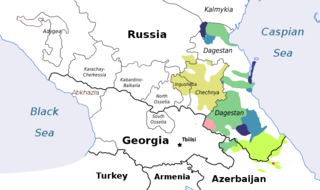Related Research Articles

The Northeast Caucasian languages, also called East Caucasian, Nakh-Daghestani or Vainakh-Daghestani, or sometimes Caspian languages, is a family of languages spoken in the Russian republics of Dagestan, Chechnya and Ingushetia and in Northern Azerbaijan as well as in Georgia and diaspora populations in Western Europe and the Middle East. According to Glottolog, there are currently 36 Nakh-Dagestanian languages.

The Nakh languages are a group of languages within the Northeast Caucasian family, spoken chiefly by the Chechens and Ingush in the North Caucasus.
Robert D. Van Valin Jr. is an American linguist and the principal researcher behind the development of Role and Reference Grammar, a functional theory of grammar encompassing syntax, semantics, and discourse pragmatics. His 1997 book Syntax: structure, meaning and function is an attempt to provide a model for syntactic analysis which is just as relevant for languages like Dyirbal and Lakhota as it is for more commonly studied Indo-European languages.
Chechen is a Northeast Caucasian language spoken by approximately 1.8 million people, mostly in the Chechen Republic and by members of the Chechen diaspora throughout Russia and the rest of Europe, Jordan, Austria, Turkey, Azerbaijan, Ukraine, Central Asia and Georgia.
The history of Chechnya may refer to the history of the Chechens, of their land Chechnya, or of the land of Ichkeria.

The Caucasian languages comprise a large and extremely varied array of languages spoken by more than ten million people in and around the Caucasus Mountains, which lie between the Black Sea and the Caspian Sea.

The Chechens, historically also known as Kisti and Durdzuks, are a Northeast Caucasian ethnic group of the Nakh peoples native to the North Caucasus. They are the largest ethnic group in the region and refer to themselves as Nokhchiy. The vast majority of Chechens are Muslims and live in Chechnya, an autonomous republic within the Russian Federation.
Ingush is a Northeast Caucasian language spoken by about 600,000 people, known as the Ingush, across a region covering the Russian republics of Ingushetia, Chechnya, North Ossetia, as well as the countries Turkey, Kazakhstan, Jordan, Syria, Lebanon, et al.

Ingushetia or Ingushetiya, officially the Republic of Ingushetia, is a republic of Russia located in the North Caucasus of Eastern Europe. The republic is part of the North Caucasian Federal District, and shares land borders with the country of Georgia to its south; and borders the Russian republics of North Ossetia–Alania to its west and north and Chechnya to its east and northeast.
Ingush, historically known as Durdzuks, Gligvi and Kists, are a Northeast Caucasian ethnic group mainly inhabiting the Republic of Ingushetia in central Caucasus, but also inhabitanting Prigorodny District and town of Vladikavkaz of modern day North-Ossetia. The Ingush are predominantly Sunni Muslims and speak the Ingush language.

The Koban culture or Kuban culture, is a late Bronze Age and Iron Age culture of the northern and central Caucasus. It is preceded by the Colchian culture of the western Caucasus and the Kharachoi culture further east.
Lyle Richard Campbell is an American scholar and linguist known for his studies of indigenous American languages, especially those of Central America, and on historical linguistics in general. Campbell is professor emeritus of linguistics at the University of Hawaiʻi at Mānoa.
Marianne Mithun is an American linguist specializing in American Indian languages and language typology. She is a professor of linguistics at the University of California, Santa Barbara, where she has held an academic position since 1986.
Linguistic Diversity in Space and Time is a 1992 book by linguist Johanna Nichols. It is her best-known work, pioneering the use of linguistic typology as a tool for understanding human migrations in prehistory.

The Nakh peoples are a group of North Caucasian peoples identified by their use of the Nakh languages and other cultural similarities. These are chiefly the ethnic Chechen, Ingush and Bats peoples of the North Caucasus, including closely related minor or historical groups.
Randy John LaPolla is a professor and former Head of Division at the Division of Linguistics and Multilingual Studies in Nanyang Technological University. He is also a Fellow of the Australian Academy of the Humanities, elected 2008. He is currently Professor of Linguistics at the Center for Language Sciences at Beijing Normal University's Zhuhai campus, and Associate Fellow of CLASS, Nanyang Technological University.
Balthasar Bickel is a Swiss linguist. Bickel is a specialist in linguistic typology and on Tibeto-Burman languages, especially languages of the Kiranti group.

Alice Carmichael Harris is an American linguist. She is Professor emerita of Linguistics at the University of Massachusetts Amherst.
Greville G. Corbett is Distinguished Professor of Linguistics at the University of Surrey and founder member of the Surrey Morphology Group.
Edith Andrea Moravcsik is a Hungarian-born American linguist.
References
- ↑ "Johanna Nichols, Ph.D." www.wiko-berlin.de. Archived from the original on 2018-06-17. Retrieved 2018-06-17.
- ↑ "UC Berkeley Linguistics PhD dissertations". lx.berkeley.edu. Retrieved 2018-06-17.
- ↑ Johanna Nichols - Google Scholar citations
- ↑ "Science Notes 1999—Echoes from the Past". sciencenotes.ucsc.edu. Retrieved 2018-06-17.
- ↑ Bickel, Balthasar; Grenoble, Lenore A.; Peterson, David A.; Timberlake, Alan, eds. (15 December 2013). Language Typology and Historical Contingency: In honor of Johanna Nichols. John Benjamins Publishing Company. ISBN 9789027270801 . Retrieved 2018-06-17.
- ↑ "Leonard Bloomfield Book Award Previous Holders" . Retrieved 2021-03-31.
- ↑ "LSA Fellows By Name | Linguistic Society of America". www.linguisticsociety.org. Retrieved 2022-12-26.
- ↑ "Johanna Nichols | Academia Europaea". www.ae-info.org. Retrieved 2023-11-27.